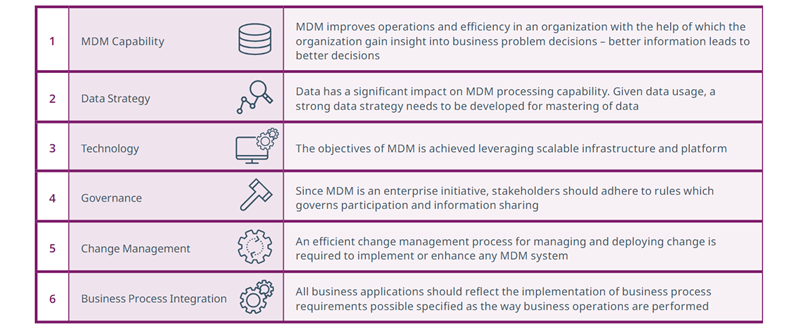A purpose-built life sciences information management solution leveraging a multi-domain approach to manage enterprise data for consistent, reliable and faster access to insights.
Achieving a mature master data management system (MDM) does not happen overnight. And it is not just a matter of securing the proper technology to get the job done. The implementation process itself requires cultural change and engagement across all internal stakeholders. This purposeful buy-in on the part of all involved is equally as important as selecting the right technology.
Five Critical Success Factors
MDM maturity requires companies to address these critical topics:
- Cross-organizational agreement on the purpose and strategy for handling enterprise data; define clear and realistic MDM objectives and targets
- Education across functions on awareness of the importance of master data and data handling; align organizational culture and goals and manage buy-in
- Early involvement of end users to assess their needs for enhancement of usability and acceptance
- Appropriate staff selection, partnership-based communication among all stakeholders; ensure that sufficient time and resources are provided for implementation
- Continuous focus to maintain and grow the quality of the Master Data assets to ensure a permanent quality of data and data flow
In addition to cultural readiness, the five key platform essentials for master data management are data model, data integration, data quality, application program interface (API) for external content providers/systems, and data governance.
Asking the Important Questions
Before embarking on a comprehensive MDM strategy, it is imperative to ask the implementation team key questions, such as:
- How is data processed and how is the data quality assured?
- Are there structural weaknesses that need to be eliminated?
- What are the unmet needs?
By analyzing the current situation, the requirements for the new system can be documented based on the defined goals. This project setup requires detailed elaboration, as it forms the basis for measuring the project’s success.
[Figure 1] 6 DIMENSIONS OF MDM MATURITY MODEL

How Can You Evaluate Your Return on Investment?
ROI is always difficult to evaluate and prove, especially for backend solutions, so we suggest estimating the impact and benefit of your MDM strategy from different perspectives:
- Revenue increase (financial)
- Cost reduction (financial)
- Efficiency gain (operational)
Each of the 6 dimensions above can contribute to a certain extent to the realization of these benefits.
- MDM Capability—When you embrace an MDM program it is key to consider the pre-built functionalities that the chosen solution will bring: the more you have to configure or, even worse, customize, the more costly and hard to build and maintain the solution will be. A mature MDM solution for life sciences shall come with all the key industry standard requirements pre-configured and should be able to help you save time and up to 30% of implementation and maintenance costs.
- Data Strategy—You need to be able to implement the right processes and workflow to manage the data according to the need and consider the flexibility of the solution to accommodate changes that more frequently happen. Utilizing modern technology correctly tailored to the industry, you should be able to automate data management processes resulting in 20% savings.
- Technology—Modern technology should ensure scalability, which means the solution will follow the company needs and maturity growth, resulting in faster, more cost-effective adoption of the solution as it evolves through time. When making your selection, don’t underestimate the upgrade/maintenance requirements that some old technologies still require that will significantly increase your total cost of ownership (TCO) in the long run.
- Governance and Change Management—It is absolutely not only about technology; a mature MDM program shall include strong governance with the early involvement of all key stakeholders. Therefore, the selection of the right team, both internal and external, is a critical success factor. This allows program buy-in and reduces the risk of poor adoption that may result not only in the loss of all incurred costs but will also generate/increase inefficiencies that easily translate to increased/unexpected costs.
- Business Process Integration—An MDM that easily integrates with any type of business system will help reduce the hidden cost of wrong data that impacts business strategy, lowering the instance of missed opportunities while increasing the success of all MDM activities. It can also reduce delays in market approval while shortening the go-to-market time of the products. These activities can represent significant gains for the organization.
Not all companies are equal and therefore no two MDM strategies are the same. While there is no pre-defined formula for choosing the right strategy, you can gain superior ROI from your investment by ensuring that your strategy is mature. This entails choosing the right solution with partners who will support you through the implementation and evolution of the MDM system that is right for you.
Related solutions
Connect data across your organization with master data management and data warehouse capabilities, and transform the way you make business decisions.

























